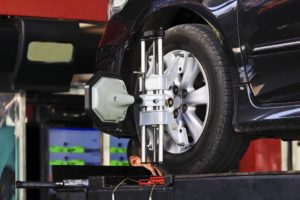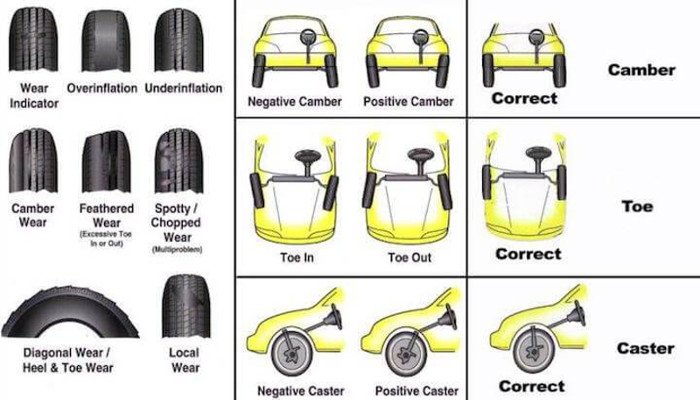Tire Alignment Near Me
Taking your car to the shop can feel like you’re back in 10th grade algebra. You are trying valiantly to pretend you know what the teacher is saying, hoping she doesn’t ask you any questions. The mechanic says your “car needs an alignment” and you’ve no choice but to nod and hope it’s cheap. Below is a basic guide to shed light on what a tire alignment is, and how to know when you need one. I’ll also share my experience with the shop that does tire alignment near me.
Tire Alignment Near Me – Find a Wheel Alignment Service Shop
Need “Tire Alignment Near Me”? Use the map below for all of the local service shops that can perform a suspension alignment.
A Tire Alignment is… What, Exactly?
Though it’s sometimes called a “tire” alignment, an alignment isn’t actually fixing a problem with your tires or wheels. An alignment is a repair to your car’s suspension system, or the part of the car that attaches the body to the wheels. It’s called a tire alignment because part of the procedure involves adjusting the angle that the tires sit on the body of the car. This angle, in turn, changes the way they make contact with the road.
There are three things to think about when your car needs an alignment – camber, caster, and toe. Camber refers to the angle of the front tires when you are facing the front of the car. If they are tilted too far out or in, they need an alignment. Toe also refers to the angle of the front tires, but looking down at them from above. The same rules apply – if they are tilted too far out or in, you need to get an alignment. Caster does not refer to the tires, but to the steering axis in the center of your wheels.
When looking at the car from the side, if the steering axis is tilted too far to the left or right, your car needs an alignment.
Causes of Uneven Tire Wear Due to Poor Alignment
Since this is a used tire blog, we often closely inspect the type of tread wear on used tires. You can often tell when a tire was the victim of poor alignment. If you are buying used its helpful to understand some tire basics and how to evaluate the tread wear properly for safety.
When Should I Align My Tires?
A wheel alignment is a repair, not something that is part of a regular maintenance routine. There are a few major indicators that your car may need an alignment.
The first is uneven tire wear. If one or two of your tires are significantly more worn than the others, it can cause problems with steering. This affects your ability to control the car. If you notice signs of uneven tire wear when driving or by visual cues, you may want to see if you need an alignment.
Another sign is pulling in the steering wheel. Ideally, if you were to take your hands off of the steering wheel while driving (which, of course, you would never do) the car would continue to drive in a relatively straight line. If the car feels like it’s going to veer off the left or right if you relax your grip on the wheel, this can be a big indicator that your car needs a tire alignment. Similarly, if you need to hold the steering wheel at an angle while driving straight, you need of an alignment.
What are the Benefits of Aligning Wheels?
An alignment is a repair, meant to fix some part of the suspension system that has become dysfunctional. Making sure your tires are properly aligned is crucial for safe driving. A faulty suspension system can lead to steering trouble. Mis-aligned tires can cause the car to veer sharply to the right or left, dramatically decrease the lifespan of your tires, and make it difficult to control the car. A mis-aligned caster, especially, can cause problems with steering, turning, and stability. Mis-alignments are typically caused by natural wear-and-tear, especially in old cars. “Natural wear-and-tear,” however, can indicate worn parts in the car’s suspension system, especially worn bearings and ball-joints. These little parts hold the suspension system together. If they are falling apart, they must be replaced if you want to continue driving safely.
An alignment can not only save your tires and make your car safer to drive, it can also save your suspension system by revealing deeper internal problems. The suspension system connects the body of the car to the wheels. A faulty suspension system can most certainly make a car dangerous and difficult to drive.
Where Can I Get a Tire Alignment Near Me?
A wheel alignment can be a big job, and one that is not normally recommended to be done at home. You can request that your alignment be checked as part of your annual inspection. This will catch alignment problems before they turn into bigger suspension problems. It is absolutely recommended that you check the alignment after getting a new set of tires (or used). Often tire manufacturers will offer alignment checks for free with the purchase of new tires.

How much Does a Wheel Alignment Cost?
If only two wheels are off, you shouldn’t pay more than $75 for a tire alignment. Double that, of course, if all four tires are off. However, many shops recommend doing a tire rotation at the same time to counteract any uneven tire wear caused by the mis-alignment. Since it is a relatively common repair, some shops offer alignment warranties for as much as $200. If you drive a lot, especially on harsh or unpaved roads, this may be a worthwhile investment, as wear-and-tear is the number one culprit for mis-aligned tires.
Alignments can start to become more pricey when it’s not the tires that are in trouble, but the front axle. The front axle is critical for steering, and so if the axle is damaged it absolutely must be replaced, and the wheels subsequently re-aligned. However, replacing a front axle can cost as much as $150 for the part, and double that for labour. Regularly rotating your tires and doing annual alignment checks can help you to spot axle problems before the steering system degenerates to the point of replacement..
What’s the Difference Between Balancing and Alignment?
Balancing is often recommended to be done at the same time as an alignment, but they are technically two different procedures. A tire alignment is a repair that targets problems in the car’s suspension system. An alignment typically takes the form of adjusting the angle of the tires so that the front and back tires are perfectly lined up. Balancing, on the other hand, has to do with weight distribution across the wheels and tires. An improper alignment can cause your tires to become unbalanced, which will make the car drivable, but will ultimately cause uneven tire wear and shorten the lifespan of your tires.
Balancing should be a regular part of a tire alignment. Make sure that your tires will be balanced as well as aligned. Even if your alignment is ultimately a problem with the front axle, rather than the tires, the tires should still be balanced after the axle is replaced. Again, the process of replacing the axle can cause your tires to become unbalanced. It can ultimately lead to yet another tire alignment in the future.
What’s the Difference Between Rotation and Alignment?
An alignment is a repair, intended to fix a problem in the car’s suspension system. When you drive your brand new car out of the dealership parking lot, the alignment is pristine. A rotation, on the other hand, is a standard maintenance procedure, on the same routine level as an oil change. A tire rotation means changing the position of the tires to ensure even tire wear. Going too long without a tire rotation can severely clip the lives of your tires. Routine tire rotations can also be preventative in terms of tire alignments, as the tires should be perfectly aligned when they are re-fitted to the body of the car. Wheel alignments are often made necessary because of uneven tire wear, and so regular rotations will not only increase the lifespan of your tires, but can help to preserve their alignment over time.
It’s often recommended to do a tire rotation and an alignment at the same time. Mis-alignment in the tires can sometimes cause problematic tire wear patterns. Rotating the tires can go a long way toward correcting any uneven tire wear that was caused by the mis-alignment.
Tire Alignment Near Me Conclusion…
Tire alignments are a very common repair. They are recommended by some dealerships to be done every 10,000 miles for optimum performance. That being said, keeping up with routine tire maintenance services like rotations and balancing can often prevent the need for an alignment, sometimes for years. While the repair is typically called a “tire alignment,” it’s actually a repair that makes adjustments to the car’s suspension system. That’s the part of the car that connects the body to the wheels. Since the suspension system directly affects steering, turning, and driving stability, mis-aligned tires cannot be ignored for long.
An annual alignment check can prevent the need for more intensive alignments, like replacing the car’s front axle. This can not only save your tires and prolong the life of your car, but it can save you a big repair bill also. While a basic alignment will typically cost around $75, replacing the front axle can easily cost you twice as much. Finally, though tire alignment, balancing, and rotation are technically three separate procedures, it’s recommended to do all three together. Failure to do one of these repairs can often necessitate the other two. That’s what I have learned from the shop that does tire alignments near me.
